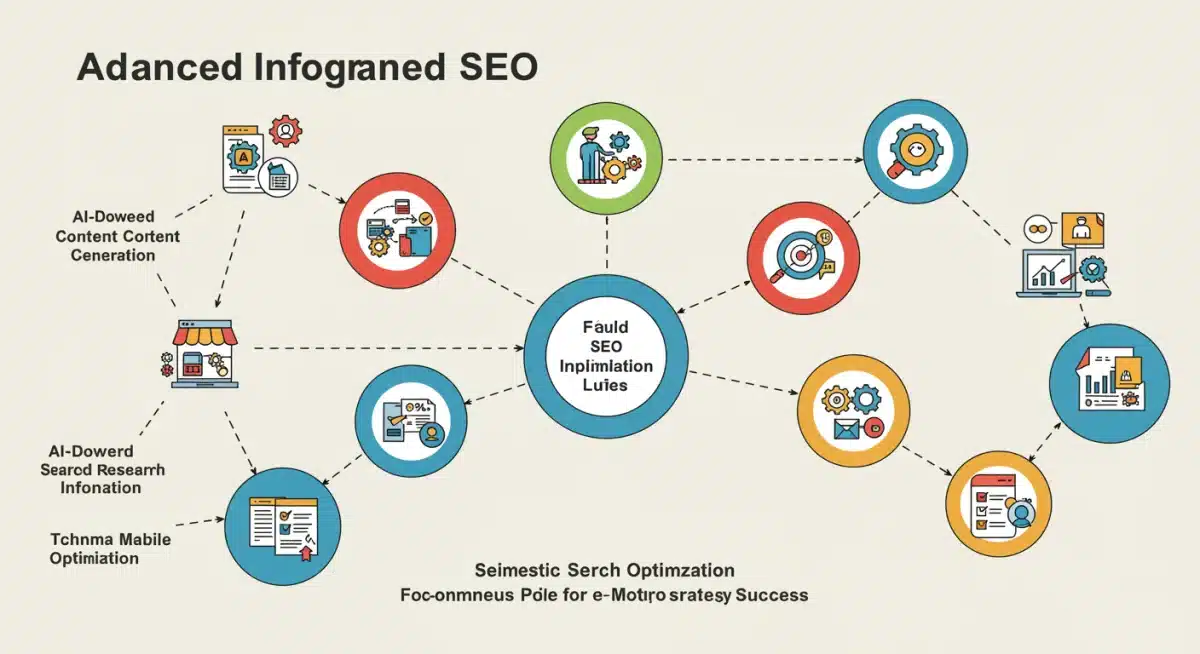Advanced SEO Tactics for US E-commerce: 2025 Organic Traffic Growth

As the digital landscape evolves rapidly, US e-commerce businesses are urgently seeking to implement Advanced E-commerce SEO Tactics to secure a competitive edge and achieve significant organic traffic increases by 2025.
Decoding Semantic Search and AI for E-commerce
The shift towards semantic search and the pervasive integration of artificial intelligence (AI) are fundamentally reshaping how e-commerce sites must approach SEO. Google’s algorithms are becoming increasingly sophisticated, moving beyond keyword matching to understand user intent and context.
This means that simply stuffing keywords is no longer effective; instead, a deep understanding of natural language and user queries is paramount. E-commerce platforms that master semantic optimization will be best positioned to capture organic traffic.
Leveraging AI for Content Generation and Optimization
AI tools are now capable of assisting in various stages of content creation and optimization, from generating product descriptions to crafting blog posts that resonate with specific audience segments. This technology allows for scalability and efficiency previously unattainable.
- AI-powered keyword research identifies long-tail and conversational queries.
- Automated content audits pinpoint gaps and opportunities for topical authority.
- Personalized content delivery based on user behavior enhances engagement.
- Sentiment analysis helps refine brand voice and messaging for target audiences.
The strategic deployment of AI ensures content is not only relevant but also structured in a way that aligns with complex search engine understanding, driving higher organic visibility.
Enhancing Technical SEO for Core Web Vitals and User Experience
Technical SEO remains a cornerstone of any successful strategy, with Core Web Vitals (CWV) now playing a direct role in search rankings. E-commerce sites, often laden with images and dynamic content, face particular challenges in meeting these performance metrics.
Optimizing site speed, interactivity, and visual stability is no longer just a best practice; it’s a ranking factor. Businesses must invest in robust infrastructure and continuous monitoring to ensure their sites deliver an exceptional user experience on all devices.
Implementing Schema Markup for Rich Snippets
Schema markup provides search engines with structured data about your products, prices, reviews, and availability. This allows for rich snippets in search results, making your listings stand out and improving click-through rates.
- Product schema enhances visibility for individual product pages.
- Review schema displays star ratings, building trust and authority.
- FAQ schema can capture valuable SERP real estate.
- Local business schema is vital for brick-and-mortar e-commerce operations.
Correctly implemented schema not only boosts visibility but also helps search engines categorize and understand your offerings more accurately, leading to better matching with user queries.
Dominating E-A-T and Brand Authority in Competitive Niches
Expertise, Authoritativeness, and Trustworthiness (E-A-T) are critical factors, especially in sectors where product quality and reliability are paramount. For US e-commerce, building a strong brand authority is essential to stand out amidst fierce competition.
This goes beyond simple backlinks; it involves demonstrating genuine expertise through high-quality content, industry recognition, and positive customer experiences. Google’s algorithms are increasingly adept at identifying and rewarding sites that exhibit strong E-A-T signals.
Cultivating Thought Leadership and Industry Recognition
Developing thought leadership through insightful blog posts, whitepapers, and expert interviews can significantly elevate a brand’s authority. Collaborating with industry influencers and participating in relevant forums further solidifies this position.
Showcasing customer testimonials, case studies, and awards also plays a crucial role in building trust. These elements collectively signal to search engines and users that your e-commerce site is a credible and reliable source for products and information.
The emphasis on E-A-T reflects a broader trend toward rewarding genuine value and trustworthiness in the digital space, making it a non-negotiable element for long-term SEO success.
Leveraging Voice Search and Conversational SEO
With the proliferation of smart speakers and virtual assistants, voice search is no longer a futuristic concept but a present reality impacting how users search for products. E-commerce sites must adapt their SEO strategies to account for conversational queries.
Voice searches are typically longer, more natural, and question-based compared to traditional text searches. Optimizing for these queries involves understanding the nuances of natural language processing and anticipating user intent in a conversational context.
Optimizing for Long-Tail and Question-Based Keywords
The foundation of voice search optimization lies in targeting long-tail keywords and question-based phrases. These queries often have lower search volume but higher conversion rates due to their specificity and clear user intent.
- Answering common questions directly within product descriptions and FAQs.
- Creating content that mimics natural conversation patterns.
- Using structured data to highlight answers for quick voice assistant retrieval.
- Focusing on local SEO for ‘near me’ searches, common in voice queries.
By tailoring content to address these conversational patterns, e-commerce sites can effectively capture a growing segment of organic traffic.

Advanced Link Building and Digital PR Strategies
While content and technical foundations are critical, a robust link building strategy remains indispensable for boosting domain authority and organic rankings. However, the nature of effective link building has evolved.
Gone are the days of mass link acquisition. Today, the focus is on acquiring high-quality, relevant backlinks from authoritative sites through strategic outreach and digital public relations (PR) efforts. These links act as powerful votes of confidence from other reputable sources.
Building Relationships and Earning Editorial Placements
Effective link building for e-commerce now often involves building genuine relationships with journalists, bloggers, and industry influencers. This approach focuses on earning editorial placements rather than simply requesting links.
Creating shareable content, such as original research, compelling infographics, or unique product stories, can attract organic mentions and backlinks. Digital PR campaigns can also amplify reach and secure placements on high-authority news sites and industry publications.
The goal is to demonstrate genuine value that naturally encourages others to link back to your site, signaling to search engines that your e-commerce platform is a valuable and trusted resource.
Data-Driven Personalization and User Journey Optimization
In the competitive e-commerce landscape, personalization is no longer a luxury but a necessity. Leveraging data to understand individual user behavior and tailor the shopping experience can significantly impact organic traffic and conversion rates.
This involves analyzing user paths, identifying pain points, and dynamically adjusting content and product recommendations to meet specific needs. A seamless and personalized user journey not only improves customer satisfaction but also sends positive signals to search engines about site quality and relevance.
Utilizing Analytics for Conversion Rate Optimization (CRO)
Beyond simply attracting traffic, advanced SEO for e-commerce integrates directly with Conversion Rate Optimization (CRO). Understanding how users interact with your site once they arrive is crucial for maximizing the value of organic traffic.
- A/B testing different page layouts and call-to-actions.
- Analyzing heatmaps to identify user engagement patterns.
- Optimizing checkout flows to reduce cart abandonment.
- Personalizing product recommendations based on browsing history.
By continuously refining the user journey based on data insights, e-commerce sites can ensure that their increased organic traffic translates into tangible business results, solidifying their market position for 2025 and beyond.
| Key Tactic | Brief Description |
|---|---|
| Semantic Search & AI | Optimizing content for user intent and natural language queries using AI tools. |
| Technical SEO & CWV | Ensuring site speed, interactivity, and stability, including rich snippet implementation. |
| E-A-T & Brand Authority | Building expertise, authoritativeness, and trustworthiness through high-quality content and recognition. |
| Voice Search Optimization | Tailoring content for conversational, question-based queries from voice assistants. |
Frequently Asked Questions About Advanced E-commerce SEO
Core Web Vitals are a set of metrics measuring real-world user experience for loading performance, interactivity, and visual stability. They are crucial because Google uses them as ranking signals, directly impacting an e-commerce site’s visibility and organic traffic potential.
AI significantly influences e-commerce SEO by enhancing keyword research, automating content generation, personalizing user experiences, and optimizing content for semantic search. This allows for more efficient and effective strategies to meet evolving algorithm demands.
E-A-T stands for Expertise, Authoritativeness, and Trustworthiness. E-commerce sites can improve it by creating high-quality, informative content, securing reputable backlinks, displaying customer reviews, and showcasing industry recognition to build brand credibility.
Optimizing for voice search is essential due to the rise of smart devices and virtual assistants. Voice queries are often conversational and question-based, requiring e-commerce sites to adapt content and use structured data to capture this growing segment of organic traffic.
Advanced link building moves beyond mass acquisition to focus on earning high-quality, relevant backlinks from authoritative sources. It emphasizes digital PR, relationship building, and creating valuable content that naturally attracts editorial mentions and links.
What Happens Next
The strategic imperative for US e-commerce sites is clear: embracing these Advanced E-commerce SEO Tactics is not optional but fundamental for sustained growth. Businesses that proactively integrate AI, refine technical SEO, build E-A-T, and adapt to voice search will likely see significant gains in organic traffic by 2025. Those lagging behind risk losing market share in an increasingly competitive digital landscape. Continuous monitoring and adaptation to algorithm updates will be key to maintaining this momentum.